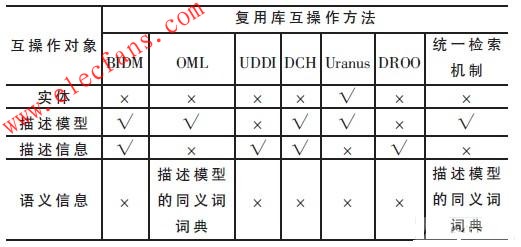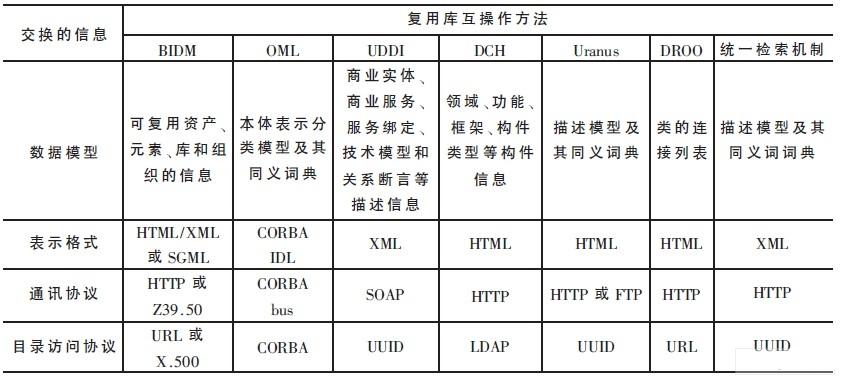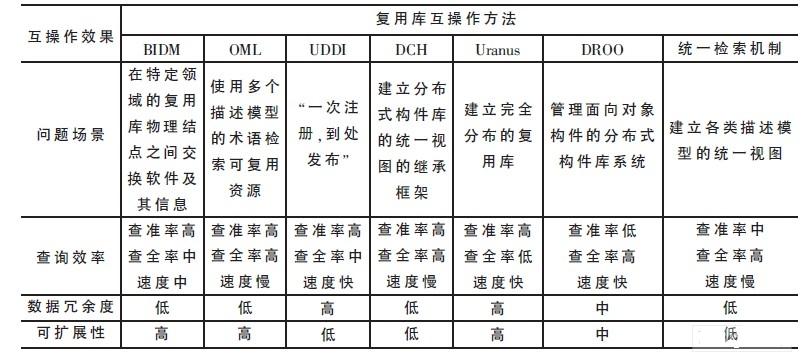With the development of Internet and network technology, multiplexing libraries running on the Internet are also increasing. Each developer and manager of multiplexing libraries will organize and manage the resources in the multiplexing library for specific fields or user groups. And provide corresponding services. However, many components required by users often do not only exist in one software reuse library, and the existence of these independent reuse libraries will require users to access multiple reuse libraries to obtain the required components, which will lead to Redundancy and reduced search efficiency. Allowing these reuse libraries to manage and maintain the components stored in the library in their own specific way, while allowing users to transparently access and retrieve the components in multiple reuse libraries through an interface, this is to improve the reuse efficiency and complexity of components The possibility of using is very necessary, so the interoperability method of software reuse library appears. The previous research on the interoperability method of the reuse library is simply from the perspective of the operation object, and the interoperability of the reuse library is divided into two levels of interoperability at the directory level describing resources and interoperability at the actual resource level, and There is no comprehensive comprehensive comparison and analysis of various methods. 1 Comparison of interoperability methods of multiplex libraries This article will interoperate with existing multiplexing libraries from five aspects: interoperability objects, exchanged information, core technologies used, supported systems / tools, and interoperability effects. BIDM, OML, UDDI, DCH, Uranus, DROO and unified search mechanism for classification and comparison. 1.1 Classification comparison on interoperable objects Different methods of interoperable objects are different, as shown in Table 1. Table 1 Classification comparison on interoperable objects 1.2 Classification comparison on exchanged information An important aspect of multiplex library interoperability is to exchange information between multiplex libraries. To exchange information, you need a specific description method or a specific representation format to describe the information that needs to be exchanged. This can be divided into three levels. (1) Data model layer: The data model layer abstractly defines the information to be exchanged between multiplexing libraries. Different methods usually use different data models due to different interoperable objects. (2) Representation format layer: The presentation format layer specifies how to correctly describe the format of the data model instance. Common presentation formats include HTML, XML, and GML. (3) Protocol layer: The protocol layer describes the "session" method used to exchange information between two nodes. It is mainly divided into two types: communication protocol and directory access protocol. Common communication protocols are HTTP, FTP, SOAP, Z39.50, and common directory access protocols are X.500 [5], URL, LDAP, ID, etc. Because the interoperability objects of each method are different, the information exchanged by each method is also different. Table 2 shows the specific classification and comparison results of the information exchanged by the multiplexing library interoperability method. Table 2 Classification comparison on exchanged information It can be seen that most methods support communication protocols on the Internet, but the directory access protocols used are different. The data model used by each method is also different, and the presentation format provided is also slightly different, but in order to be able to interact on the Internet, most methods support the representation format of HTML or XML. 1.3 Classification comparison in core technology The multiplexing library interoperation method mainly solves the two problems of exchanging data information and using data information to query reusable resources. The "core technology" perspective illustrates the main technologies and common architectures used by these methods to solve these two problems. Common architectures are mainly centralized and distributed. In the centralized method, there is a virtual library core node or intermediate conversion node, each multiplexing library exchanges its own data information to the node, and the user uses the data information through this node. In the distributed method, each multiplexing library directly exchanges data information according to a specific communication diagram, and users can directly use the data information at the multiplexing library node. Table 3 shows the classification and comparison results of multiplexing library interoperability methods from the perspective of "core technology". It can be found that most of the distributed architecture systems support local queries, and most methods provide redirection technology, because the synchronous replication technology will cause data redundancy problems, but the synchronous replication mechanism can better ensure data consistency. Table 3 Comparison of core technologies 1.4 Classification comparison on supported systems and tools Generally speaking, to achieve interoperability of multiplexed libraries requires corresponding systems or tools to support the implementation of interoperability methods. Support systems or tools for interoperability of multiplex libraries can usually be divided into management tools and query tools. Among them, the management tool is responsible for the operations related to the exchange of data information, mainly in terms of whether it supports the registration of new nodes, the modification of data information, and the real-time modification of data information. According to different needs and implementation technologies, different Support systems or tools will provide management tools with different functions. The query tool is responsible for related operations of querying with the exchanged data information, mainly from sub-functions such as whether to provide query conversion function, whether to merge query results, whether to sort the query results and other sub-functions. The support systems or tools provided by each method are mainly based on the functions provided by the multiplexing library in the traditional sense, and additional tools or systems are needed. Under normal circumstances, most of the methods using a centralized architecture will provide support systems to assist in the completion of interoperability between library nodes; most of the methods using a distributed architecture will add some additional management required for interoperation on the original system Facilities or interoperability tools. Table 4 shows the comparison results of the multiplexing library interoperability methods from the perspective of "supported systems and tools". Table 4 Classification comparison on supported systems and tools 1.5 Classification comparison on interoperability effects Different methods use different technologies, resulting in different interoperability effects of each method. This article mainly classifies and compares the effects of different methods from four aspects: problem solving, query efficiency, data redundancy and scalability. The "problem scenario" describes the scope of the problem that the method can solve and the goal to be achieved. "Query efficiency" illustrates the query effectiveness of each method from three perspectives: precision rate, recall rate and query speed. "Data redundancy" describes the relative degree of redundancy of each method from three levels (high, medium, and low). "Scalability" refers to whether additional operations or modifications are required for interoperable multiplex library nodes in the method. If more operations or modifications are required, the scalability is lower, and if there are fewer additional operations and modifications, the scalability is higher. From the perspective of "interoperability effect", by classifying and comparing the interoperability methods of multiplexed libraries, you can find out which of the multiplexed library interoperability problems can be solved or can be improved. Since there is no quantitative experimental data comparison between the methods, only the relative methods are used to compare the interoperability effects of the various methods, as shown in Table 5. Table 5 Classification comparison on the effect of interoperability 2 Results analysis Through analysis and comparison, it can be concluded that the current methods and systems have the following characteristics: (1) Most methods or systems provide interoperability with description models and description information. Because the interoperability of entities involves intellectual property issues and increases the redundancy of data, most methods do not support copying the same entity on multiple nodes, and interoperability of semantic information is rarely provided. The OML method and unified retrieval mechanism provide interoperability on semantic information, but only through the synonym dictionary. The establishment of the thesaurus is performed by the administrator, which increases the workload and difficulty of the administrator. (2) The data model of the information exchanged by each method is different, but basically all provide representation formats and protocols that can be communicated and accessed on the Internet. (3) The core technology adopted by each method is different, but it is mainly divided into two types: centralized query distribution technology and distributed local query mechanism. (4) Each method will provide suitable management tools and simple query tools, but few methods provide better results merge and result reordering functions. (5) The problem requirements of each method are different, so the technology and data model used are different, resulting in different interoperability effects of each method. However, they have room for improvement in terms of accuracy and recall, query speed, data redundancy, and scalability. In addition, according to different problem requirements and scenarios, it is necessary to select the appropriate method to achieve better results. UGR LED Downlight,LED Recessed Downlight,UGR Adjust LED Downlight,UGR LED Commercial Downlight SHENZHEN KEHEI LIGHTING TECHNOLOGY CO.LTD , https://www.keheiled.com




June 13, 2020